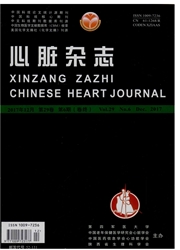

 中文摘要:
中文摘要:
目的观察低氧诱导大鼠肺微血管内皮细胞(PMVEC),是否同样存在肺血管的胰岛素敏感性变化?并探讨潜在的分子机制。方法:采用低压低氧法建立低氧性肺动脉高压(HPH)大鼠模型,14只雄性SD大鼠随机分为:正常对照组和HPH组(低氧4周),每组7只大鼠(n=7)测定两组平均肺动脉压(mPAP)及胰岛素诱导的血管舒张效应。原代培养大鼠PMVEC,分为常氧(21%O2,37℃)和低氧(10%O2,37℃)处理,分别培养6 h、24 h、48 h和96 h收集细胞以Western blot检测Tribbles同源蛋白3(TRB3)、过氧化物酶体增殖物激活受体(PPAR^y)及胰岛素的磷脂肌醇3激酶/蛋白激酶B/内皮一氧化氮合酶(P13K/Akt/eNOS)信号通路蛋白水平,培养基上清检测一氧化氮(NO)生成量。结果:与正常对照组比较,低氧组mPAP明显升高,胰岛素诱导的肺动脉血管舒张作用明显减弱(P〈0.05,P〈0.01)。PMVEC在含胰岛素的内皮培养基培养不同时间,低氧组与常氧组相比,培养6 h NO量明显升高,培养24 h后有所下降,随低氧时间的延长下降幅度增大(P〈0.01);随低氧时间延长,P13K-p85、p-Akt、p-eNOS表达逐渐下降,低氧时间越长下降幅度越明显,与NO生成相一致,p-ERKl/2随低氧时间延长表达明显升高;随低氧时间延长TRB3表达增加显著,而PPARY表达减少(P〈0.05,P〈0.01)。而不同培养时间常氧组间NO量及上述蛋白表达无显著性差异。结论:低氧可诱导大鼠PMVEC内TRB3的过表达从而负性调控PPARl,引起下游胰岛素信号通路受损,造成肺血管内皮功能异常,进而促进HPH发生。
 英文摘要:
英文摘要:
AIM: To investigate the underlying molecular mechanisms responsible for vascular insulin resistance (VIR) in pulmonary arterial hypertension (PAH). METHODS: Fourteen male Sprague Dawley rats were randomly divided into two groups: normal group and hypoxic pulmonary hypertension (HPH) group (exposed in hypobarie and hypoxia condition for 4 weeks). Pulmonary arterial pressure (PAP) and insulin-induced vasodilation effects of pulmonary artery rings were measured. Primary rat pulmonary microvascular endothelial cells (PMVEC) were cultured, respectively, in normal oxygen (21% 02, 37℃) and low oxygen (10% 02, 37℃) incubators. After cultured at 6, 24, 48, 96 h, cells were collected to detect the expression of TRB3, PPAR-Y and insulin signaling proteins by Western blot. Culture supernatant was used to detect generation of nitric oxide (NO). RESULTS: Comparedwith those in the control group, mPAP was significantly enhanced in the HPH group, whereas insulin induced vasorelaxation reaction was significantly attenuated ( n = 7, P 〈 0. 05 or P 〈 0. 01 ). Compared with that in the normoxic group, NO level significantly increased after 6 h, declined after 24 h in the HPH group and further decreased with prolonged hypoxia. Such trends of NO changes were consistent with the expressions of PI3K-p85, p-Akt, p-eNOS but contrary to those of p-ERK1/2. In addition, TRB3 was distinctly overexpressed, whereas PPAR-Y expression decreased. CONCLUSION: Hypoxia induces overexpression of TRB3 in rat PMVEC, which negatively regulates balance of insulin signaling pathways and then dysfunction of PMVEC, thus ment of PHP. PPAR-Y, leading to the im contributing to the development of PHP.
 同期刊论文项目
同期刊论文项目
 同项目期刊论文
同项目期刊论文
 期刊信息
期刊信息
